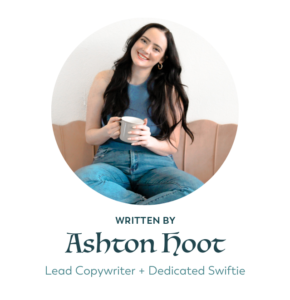Words are powerful, and nobody knows that better than copywriters. But sometimes, we have to go a little bit deeper than just tailoring action verbs to push people in the right direction to make a purchase.
Sometimes it’s about making people feel seen and heard.
That’s what language does after all, right?
Using inclusive language in your copy isn’t as hard as you think, either. You just need to make some vocab swaps and write with greater intention. And every good writer knows…writing with intention IS part of our job (no wait, that’s our actual job. We’re not making dear diary posts and Myspace bulletin board rants here).
Nobody likes feeling left out for something they can’t control. It sucks, even as an adult. So, like, don’t do that. Here’s what inclusive language means in your marketing and messaging, and how you can use it well.
What is inclusive language?
Inclusive language is words or phrases that avoid biases, slang, and expressions that discriminate against people based on race, gender, socioeconomic status, or ability. It opens the door for your brand to resonate with more people by writing in a way that makes more people feel welcome.
It’s not that hard to be nice, and it’s a win-win for everyone. So you do the math.
Inclusive language should point to your brand values
If you’re a brand that doesn’t stand for discrimination, then you should be using inclusive language.
Don’t be a hypocrite. If you’re here to make a difference, using inclusive language is literally the easiest way to do that. All it takes is for you to be mindful of what you say, and nix certain phrases from your brand vocabulary. You don’t even have to get up off your couch for that.
Yes, it is that simple.
How to use inclusive language
Using inclusive language in your business takes some TLC. We’ve been using terms and phrases for decades that we’re now realizing are very much not okay. So go back and read your ish with a fine-toothed comb and create some standards for your copy moving forward.
Use people-first language
You know what’s cool? Making people feel included. And that’s what people-first language does. Instead of using terms like, “She’s ADHD,” use “She has ADHD.”
Yes, a subtle shift, we know. But the psychological impact of what we say and how we say it is actually pretty significant. Using people-first language keeps you from reducing someone to just one aspect of their entire being.
Please note: Some people in disabled communities prefer to be referred to as “a person with disabilities” or a “a person with autism.” Other people want to be referred to as “disabled” and some want to be referred to as “autistic.” While we use people-first language as a rule of thumb, you may also see that people in some spaces use different phrasing and that’s ok!
Use gender-neutral words
Copywriters have an uncanny ability to tell stories (hehe — see what I did there?). But the downside is that we can also misuse our ability in a way that unintentionally supports negative gender stereotypes.
So instead, copywriter or not, be intentional and respectful with the words you use. This can include:
- Using “folks” or “people” rather than “you guys”
- Using “they” instead of automatically using “she” or “he”
- Using “be brave” instead of “man up”
- Using “sales rep” instead of “salesman”
Of course, these are just a few of the many examples that exist, but it’s a good starting point.
Stop using phrases that reinforce harmful ideas
It’s 2022 and it’s officially time we retire the phrase ‘girl boss.’ Yes, at Uncanny Content, this is a no-no and we cringe every time we hear it.
Why can’t we just be bosses? Why does being a female boss have to be any different than being a male boss? Kinda reduces it to the idea of “you’re pretty smart and hardworking for a girl!” huh?
Catch my drift with this?
There are plenty of other examples of this, some with varying degrees of harm and tons of controversy attached. Here are just a few things we avoid using in our copy:
- “That’s CRAZY!” No it’s not.
- “It felt a little tone-deaf.” People (like Latasha) are actually tone-deaf. Find a new phrase.
- “You’re a slave to your computer.” Please, God, stop using “slave” anywhere.
- “How badly do you want to change?” This is something we see in a lot of copy — and it indicates that some just has to want to change. Sorry, but not everyone has access to the same resources (time, money, energy, etc.) to invest in a program.
- “It’s a witch hunt.” We heard this a lot after George Floyd was murdered and people were realizing that some of their favorite brands were… not on the right side of history. Look up the history of witch hunts. Guarantee you there is NO comparison to your plight.
- “It’s my spirit animal,” “Find your tribe,” or “Let’s powwow.” No. Just no. They’re offensive and not OK to use. Period.
Educate yourself on AAVE
AAVE (African-American Vernacular English) is similar to Ebonics — a community-coined term [ebony + phonics] that was meant to refer specifically to the study of the linguistic consequences of the slave trade.
Black people, especially in America, have set trend after trend with “catchphrases” and slang. If you’re a white person or a non-Black person of color, it’s really important that we talk about AAVE and appropriation.
Just think about it: Thinks like “finna” and “catch these hands” are phrases from Black creators and communities. And yet most of us use them — especially Gen Z, but that’s a rant for another day.
If you want to avoid AAVE or least think consciously about how you use pieces from Black vernacular, this resource is one of the best we’ve ever seen. It also has examples of ableist and transphobic language.
Write specific guidelines in your copy style guide
Just like your copy style guide should have words and phrases you use frequently, it should also explicitly state what should not be used. Again, see ‘girl boss,’ ‘you guys,’ clapping emojis, etc. This keeps everyone on the same page and makes writing and editing your copy a breeze!
Part of having great content is understanding what your audience needs from you, and accommodating when you can (and I assure you, this simple language swap is something you can do). If it benefits them, it benefits you too.
But that doesn’t mean writing oodles of copy is any easier. Look, some people just don’t like writing and that is a-oh-kay. Hand it over to us. We got you — and we’ll make sure that copy is inclusive too.
Schedule a call with Latasha here!

